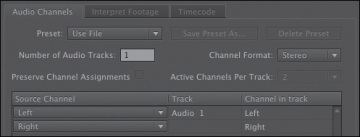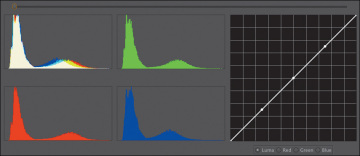Modifying clips
Premiere Pro uses metadata associated with clips to know how to play them back. Occasionally, this metadata will be wrong, and you’ll need to tell Premiere Pro how to interpret a clip.
You can change the interpretation of clips for one file or multiple files in a single step. All clips you have selected are affected by changes to interpretation.
Adjusting audio channels
Premiere Pro has advanced audio management features. You can create complex sound mixes and selectively target output audio channels with original clip audio. You can produce mono, stereo, 5.1, and even 32-channel sequences with precise control over the routing of audio channels.
If you’re just starting out, you’ll probably want to produce sequences mastered in stereo using stereo clips. In this case, the default settings are most likely exactly what you need.
When recording audio with a professional camera, it’s common to have one microphone record onto one audio channel and a different microphone record onto another audio channel. These are the same audio channels that would be used for regular stereo audio, but they now contain completely separate sound.
Your camera adds metadata to the audio to tell Premiere Pro whether the sound is meant to be mono (separate audio channels) or stereo (channel 1 audio and channel 2 audio combined to produce the complete stereo sound).
You can tell Premiere Pro how to interpret audio channels when new media files are imported by going to Edit > Preferences > Audio (Windows) or Premiere Pro > Preferences > Audio (Mac OS).
If the setting was wrong when you imported your clips, it’s easy to tell Premiere Pro how to correctly interpret the audio channels.
Right-click the Reveal clip in the Theft Unexpected bin, and choose Modify > Audio Channels.
This clip is set to use the file’s metadata to identify the channel format for the audio. Click the Preset menu, and change it to Mono.
Premiere Pro switches the Channel Format menu to Mono. You’ll see that the Left and Right source channels are now linked to tracks Audio 1 and Audio 2. This means that when you add the clip to a sequence, each audio channel will go on a separate track, allowing you to work on them independently.

- Click OK.
Merging clips
It’s quite common for video to be recorded on a camera with relatively low-quality audio, while high-quality sound is recorded on a separate device. When working this way, you will want to combine the high-quality audio with the video by merging them.
The most important factor when merging video and audio files in this way is synchronization. You will either manually define a sync point—like a clapperboard mark—or allow Premiere Pro to sync your clips automatically based on their timecode information or audio.
If you choose to sync clips using audio, Premiere Pro will analyze both the in-camera audio and the separately captured sound and match them up.
- If you don’t have matching audio in the clips you wish to merge, you can manually add a marker. If you’re adding a mark, place it on a clear sync point like a clapperboard.
- Select the camera clip and the separate audio clip. Right-click either item, and choose Merge Clips.
- Under Synchronize Point, choose your sync point, and click OK.
A new clip is created that combines the video and the “good” audio in a single item.
Interpreting footage
For Premiere Pro to interpret a clip correctly, it needs to know the frame rate for the video, the pixel aspect ratio (the shape of the pixels), and, if your clip is interlaced, the order in which to display the fields. Premiere Pro can find out this information from the file’s metadata, but you can change the interpretation easily.
- Import RED Video.R3D from the Lessons/Assets/Video and Audio Files/RED folder. Double-click the clip to open it in the Source Monitor. It’s full anamorphic widescreen, which is a little too wide for our project.
- Right-click the clip in the bin, and choose Modify > Interpret Footage.
- Right now, the clip is set to use the pixel aspect ratio setting from the file: Anamorphic 2:1. This means the pixels are twice as wide as they are tall.
- Use the Conform To menu to change the Pixel Aspect Ratio setting to DVCPRO HD (1.5). Then click OK.
From now on, Premiere Pro will interpret the clip as having pixels that are 1.5 times wider than they are tall. This reshapes the picture to make it standard 16:9 widescreen.
This won’t always work—in fact, it often introduces unwanted distortion—but it can provide a quick fix for mismatched media (a common problem for news editors).
Working with raw files
Premiere Pro has special settings for R3D files created by RED cameras, and for ARI files created by ARRI cameras. These files are similar to the Camera Raw format used by professional DSLR still cameras. Raw files always have a layer of interpretation applied to them in order to view them. You can change the interpretation at any time without impacting playback performance. This means you can make changes, for example, to the colors in a shot without requiring any extra processing power. You could achieve a similar result using a special effect, but your computer would have to do more work to play the clip.
Right-click the RED Video.R3D clip in the Project panel, and choose Source Settings.
The RED R3D Source Settings dialog box appears, giving you access to the original interpretation controls for the clip. In many ways, this is a color correction tool, with automatic white balance and individual adjustments for the red, green, and blue values.
- On the right, you’ll see a series of individual controls for adjusting the picture. Scroll down to the end of the list, where you’ll find Gain settings. Since this is a RED clip, increase the Red gain to about 1.5. You can drag the slider control, drag the orange number, or click and type over the number.
Click OK, and take another look at the clip in the Source Monitor.
The picture has updated. If you had already edited this clip into a sequence, it would update inside the sequence too.
For more information about working with RED media, go to www.adobe.com/products/premiere/extend.
The ARRI AMIRA camera can associate color interpretation settings (known as a lookup table, or LUT) with the media files as it creates them. Premiere Pro recognizes these LUTs and applies them as a Lumetri Look Master clip effect (see Chapter 13, “Adding Video Effects,” for more information about Master clip effects).

